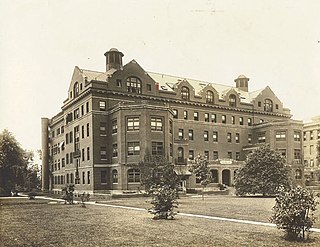This page is based on this
Wikipedia article Text is available under the
CC BY-SA 4.0 license; additional terms may apply.
Images, videos and audio are available under their respective licenses.

The Staatliches Bauhaus, commonly known as the Bauhaus, was a German art school operational from 1919 to 1933 that combined crafts and the fine arts, and was famous for the approach to design that it publicized and taught.
The year 1911 in architecture involved some significant architectural events and new buildings.

The first Werkbund Exhibition of 1914 was held at Rheinpark in Cologne, Germany. Bruno Taut's best-known building, the prismatic dome of the Glass Pavilion of which only black and white images survive today, was in reality a brightly colored landmark. Walter Gropius and Adolf Meyer designed a model factory for the exhibition. The Belgian architect Henri van de Velde designed a model theatre. Berlin based Margarete Knuppelholz-Roeser designed the controversial Haus Der Frau.
Der Ring was an architectural collective founded in 1926 in Berlin. It emerged from expressionist architecture with a functionalist agenda. Der Ring was a group of young architects, formed with the objective of promoting Modernist architecture. It took a position against the prevailing architecture of the time, Historicism. With the rise of National Socialism and the increasing difficulty between Hugo Häring and the other members, Der Ring dissolved in 1933.
In the meantime the German architects whose work follows newly discovered laws of design, have founded a new association. 'The Ring' — a figure of self-contained form without a head — unites a group of like-minded people to pursue their ideals in unison.
Hubert Meyer was a German Waffen-SS commander who served during World War II. He had junior postings with the Leibstandarte SS Adolf Hitler and commanded the SS Division Hitlerjugend in 1944. After the war, he became active in HIAG, a Waffen-SS lobby group.

The Fagus Factory, a shoe last factory in Alfeld on the Leine, Lower Saxony, Germany, is an important example of early modern architecture. Commissioned by owner Carl Benscheidt who wanted a radical structure to express the company's break from the past, the factory was designed by Walter Gropius and Adolf Meyer. It was constructed between 1911 and 1913, with additions and interiors completed in 1925.

Karl Ludwig Kahlbaum was a German psychiatrist.

The American Psychoanalytic Association (APsaA) is an association of psychoanalysts in the United States. APsaA serves as a scientific and professional organization with a focus on education, research, and membership development.

The New Objectivity is a name often given to the Modern architecture that emerged in Europe, primarily German-speaking Europe, in the 1920s and 30s. It is also frequently called Neues Bauen. The New Objectivity remodeled many German cities in this period.
Meyer is a surname of English, German, Dutch, or Jewish origin. Many branches of the Meyer(s) family trace their origins to ancient Anglo-Saxon culture. The name may be derived from the Old English name maire, meaning Mayor, or an officer in charge of legal matters. The name may also be derived from the German word "meiger", meaning Mayor; the name likely traces its origins to a wealthy landholder. There are various names that are connected by cognation in many instances, such as Myer, Meyr, Meier, Meijer, Mayer, Maier, Mayr, and Mair). Among German Jews, "Meyer" converged with the etymologically unconnected name "Meir", which means "one who shines" in Hebrew.
Charles Macfie Campbell (1876-1943) was a psychiatrist in the United States. He was President of the American Psychiatric Association.
Events in the year 1912 in Germany.
Events in the year 1883 in Germany.
Events in the year 1969 in West Germany and East Germany.

The Henry Phipps Psychiatric Clinic is a psychiatric school and clinic in Baltimore, Maryland. Proposed in 1908 as the first of its kind in the United States, the clinic opened on April 16, 1913 as a new section of Johns Hopkins Hospital. After a visit to the hospital to check on his other investments in the Phipps Tuberculosis Dispensary, Henry Phipps decided to donate $1.5 million to fund psychiatry at Johns Hopkins. William Welch, dean of the Johns Hopkins School of Medicine, quickly appointed Adolf Meyer as the director of the clinic, a renowned psychiatrist at the time.
The psychopathography of Adolf Hitler is an umbrella term for psychiatric literature that deals with the hypothesis that the German Führer and Reichskanzler Adolf Hitler suffered from mental illness. Both during his lifetime and after his death, Hitler has often been associated with mental disorders such as hysteria, megalomania or paranoid schizophrenia. Psychiatrists and psychoanalysts who have diagnosed Hitler as having mental disturbance include well-known figures such as Walter C. Langer and Erich Fromm. Other researchers, such as Fritz Redlich, have concluded that Hitler probably did not have these disorders.










